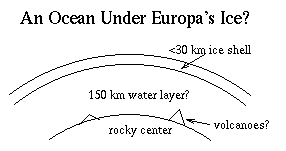
| MadSci Network: Astronomy |
Wow! That sounds like a fun project! Tell Mr. Weinandy I wish I had assignments like this one in grade school.

Europa is the second moon of Jupiter; it's a little smaller than our Moon, and has a similar gravity. Its surface is made of cracked and broken ice. If you were standing on the surface, it might look a lot like the North Pole.
But you won't find reindeer and Santa Claus there, unless they're wearing space suits. Europa has no atmosphere at all. (actually, it's got a tiny tiny bit of oxygen, hardly worth mentioning.) Also, its surface temperature is around -140 C, or (that's -200 degrees F), far colder than anywhere on Earth.
Europa's surface is a nasty place, but it might be much nicer under the ice. Last week, scientists reported that Europa has a layer of water or ice 150 kilometers (90 miles) thick. It's definitely ice on top, but the rock inside Europa is very hot, just like on Earth. We're not sure yet, but it might be hot enough to melt the ice!
This would mean Europa has a giant ocean underneath its ice. Earth's North Pole is the same way, but Europa's ice is much thicker, probably many miles, and its ocean would be ten times deeper than Earth's. Here's what it might look like:

The ice is far too thick for sunlight to get through, and plants can't live
without sunlight, and nothing can live without plants, right? So how could
anything live under the ice? A few years ago, people exploring Earth's
oceans with submarines discovered
Here's a picture of some tube worms, one of the most common of
these hydrothermal vent animals. They have no mouths or stomachs: they
just absorb bacteria that live inside their bodies for food. With things
this weird on Earth, who needs aliens?
IF Europa's core generates enough heat to melt the ice and make an
ocean, and IF this heat takes the form of undersea plumes like it
does on Earth, maybe Europa has undersea critters too. But nobody knows
what they might look like... and that's your assignment!
If you're looking for some extra credit, you might think about aliens on
Titan,
a moon of Saturn which has a thick nitrogen and methane atmosphere.
Here are some of the Web resources I used to answer your question:
Try the links in the MadSci Library for more information on Astronomy.

MadSci Home | Information |
Search |
Random Knowledge Generator |
MadSci Archives |
Mad Library | MAD Labs |
MAD FAQs |
Ask a ? |
Join Us! |
Help Support MadSci
MadSci Network
© 1997, Washington University Medical School
webadmin@www.madsci.org